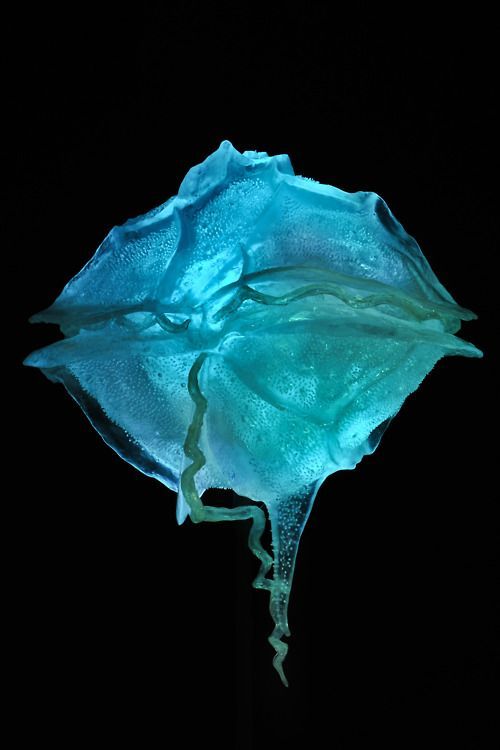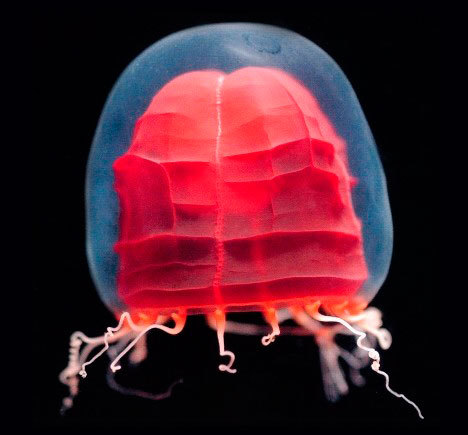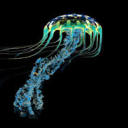Pyrodinium Bahamense


Pyrodinium bahamense
Pyrodinium bahamense is a tropical species of dinoflagellates that is found primarily in Atlantic Ocean waters. It prefers salinity around 20 psu and blooms when there are large amounts of nitrogen in the water. The dinoflagellate glows bright blue when agitated by motion. Furthermore, even though this plankton species is beautiful to look at, it causes seafood toxicity.
Photo credit: https://alchetron.com/Pyrodinium-bahamense
https://wonderchews.com/bodies-of-light/
More Posts from Bioluminescentoceangoddess and Others
Dear ocean enthusiast and supporters,
Hi everyone, thank you for supporting my blog. I have gained over 500 followers and that is worth celebrating. I will try my best to post every day some of the amazing creatures that live in the deep ocean. Have a great night!

Crystal Jellyfish
Aequorea victoria
The Crystal Jellyfish is a graceful, transparent jellyfish with long, thin tentacles. It has bioluminescent organs around it bell that produce a bright, green light. It tends to consume small copepods, but it has the ability to swallow other jellyfish half its size. Furthermore, this jelly is used in biological experiments to detect calcium.
Photo credit: https://www.montereybayaquarium.org/animals/animals-a-to-z/crystal-jelly
https://fineartamerica.com/featured/5-aequorea-crystal-jellyfish-with-amphipods-alexander-semenovscience-photo-library.html

Vampire Squid
Vampyroteuthis infernalis
Even though the Vampire Squid is named after a notorious monster, this gentle creature does not live up to its name. It is only a foot long and occupies depths between 650m to 1500m in the deep ocean. Unlike other squids, it has reduced musculature and collects particles in the water column. However, it is capable of huge bursts of speeds. It uses bioluminescence to confuse both predators.
Photo credit: https://ocean.si.edu/ocean-life/invertebrates/vampire-squid-hell
Update
Hi everyone, I apologize for the inconsistent posting. I’ve been studying for my Chemistry Praxis. :( There will be more to come soon !


Jewel Squid
Histioteuthis heteropsis
The Jewel Squid is covered in color-changing photophores that resemble sparkling gem stones. They also have a light-red coloration and are about 20 cm in length. They display a unique behavioral adaptation called diel migration. During the day, they stay at depths around 400-1200 m, and then surface during night (0-400m). This behavioral pattern is designed maximize feeding at night, and avoid predators during the day. The primary predator of the Jewel Squid is the Sperm Whale.
Photo credit: https://www.pinterest.com/pin/722827808920240115/
https://twitter.com/theoctonation/status/1168516522270253056


Red Paper Lantern Medusa
Pandea rubra
The Red Paper Lantern resembles a floating, Japanese paper lantern in the deep sea. It has the ability to crumple and wrinkle its bright, red bell, and it is located at depths between 550m to 1200m. It has also been nicknamed the “origami jelly.”
Photo credit: https://commons.wikimedia.org/wiki/Category:Pandea_rubra
http://www.thegorgeousdaily.com/pandea-rubra/


Basket Star
Gorgonocephalus caputmedusae
The Basket Star is a strange yet elegant creature that lives in the deep ocean. It resembles a flesh white ball with gnarled and swirling branches. It thrives in locations with strong currents. Its numerous arms move slowly and wrap around prey. They are one of my favorite animals from the Echinodermata phylum.
Photo credit
https://link.springer.com/article/10.1007/s00227-005-0032-3
https://en.wikipedia.org/wiki/Gorgonocephalus


Pink Helmet
Aglantha digitale
The Pink Helmet is a mini hydromedusa that comes in a variety of vibrant colors. The tiny jelly is only 4 cm in size and is found towards the surface of the ocean. The purple and blue hues we see in its bell are caused by a phenomenon known as iridescence, when light strikes the jelly’s thin tissue at different angles (similar to what we see in a soap bubbles). It also has orange pigmentation near its mouth; this pigmentation helps attract prey and mask luminescence. Furthermore, females tend to be more colorful than males.
Photo credit: https://biolum.eemb.ucsb.edu/organism/pictures/aglantha.html
https://www.pinterest.com/pin/186899453255850798/

Pram Bug
Phronima sedentaria
The Pram Bug is a deep sea amphipod that is located between 200 to 1000m in the ocean. It has a translucent exoskeleton and can see primarily blue light. It is also is contained in a hollowed out barrel that is used for protection and to house babies. The image above is a female pram bug carrying its young.
Photo Credit:https://ocean.si.edu/ocean-life/invertebrates/phronima-female-and-young





Wake up babe new fish dropped
-
 frostyspinch reblogged this · 5 months ago
frostyspinch reblogged this · 5 months ago -
 riptide-rabbitholes reblogged this · 1 year ago
riptide-rabbitholes reblogged this · 1 year ago -
 shark-from-the-park liked this · 1 year ago
shark-from-the-park liked this · 1 year ago -
 frosted-kelpie reblogged this · 1 year ago
frosted-kelpie reblogged this · 1 year ago -
 vvitchprince liked this · 1 year ago
vvitchprince liked this · 1 year ago -
 captainhowdy077 liked this · 1 year ago
captainhowdy077 liked this · 1 year ago -
 penceratepoetry liked this · 1 year ago
penceratepoetry liked this · 1 year ago -
 perpetual-pathos liked this · 1 year ago
perpetual-pathos liked this · 1 year ago -
 everoutoftouch reblogged this · 1 year ago
everoutoftouch reblogged this · 1 year ago -
 oceanlava liked this · 1 year ago
oceanlava liked this · 1 year ago -
 tumb1rprincess reblogged this · 1 year ago
tumb1rprincess reblogged this · 1 year ago -
 kissing-the-abyss reblogged this · 1 year ago
kissing-the-abyss reblogged this · 1 year ago -
 stardustandmoonflowers liked this · 1 year ago
stardustandmoonflowers liked this · 1 year ago -
 wildernestt reblogged this · 2 years ago
wildernestt reblogged this · 2 years ago -
 jiblemeza liked this · 2 years ago
jiblemeza liked this · 2 years ago -
 maxinji liked this · 2 years ago
maxinji liked this · 2 years ago -
 spiritpoyo liked this · 2 years ago
spiritpoyo liked this · 2 years ago -
 spooky-alien liked this · 2 years ago
spooky-alien liked this · 2 years ago -
 spyro4 reblogged this · 2 years ago
spyro4 reblogged this · 2 years ago -
 dragonvhs liked this · 2 years ago
dragonvhs liked this · 2 years ago -
 gardeningfrogs reblogged this · 2 years ago
gardeningfrogs reblogged this · 2 years ago -
 jellyloveru liked this · 2 years ago
jellyloveru liked this · 2 years ago -
 gardeningfrogs liked this · 2 years ago
gardeningfrogs liked this · 2 years ago -
 sea-full-of-stars reblogged this · 2 years ago
sea-full-of-stars reblogged this · 2 years ago -
 couldhavechoosensthbetter liked this · 2 years ago
couldhavechoosensthbetter liked this · 2 years ago -
 inspiration-hamster reblogged this · 2 years ago
inspiration-hamster reblogged this · 2 years ago -
 anne-wild liked this · 2 years ago
anne-wild liked this · 2 years ago -
 dead-n-cide reblogged this · 2 years ago
dead-n-cide reblogged this · 2 years ago -
 dead-n-cide liked this · 2 years ago
dead-n-cide liked this · 2 years ago -
 casspurrjoybell-1 reblogged this · 2 years ago
casspurrjoybell-1 reblogged this · 2 years ago -
 casspurrjoybell-1 liked this · 2 years ago
casspurrjoybell-1 liked this · 2 years ago -
 vladstrain liked this · 2 years ago
vladstrain liked this · 2 years ago -
 sesalan liked this · 2 years ago
sesalan liked this · 2 years ago -
 sesalan reblogged this · 2 years ago
sesalan reblogged this · 2 years ago -
 roymarkcorrales reblogged this · 2 years ago
roymarkcorrales reblogged this · 2 years ago -
 roymarkcorrales liked this · 2 years ago
roymarkcorrales liked this · 2 years ago -
 chihuahualovr reblogged this · 2 years ago
chihuahualovr reblogged this · 2 years ago -
 alykzandra liked this · 2 years ago
alykzandra liked this · 2 years ago -
 tobismoon liked this · 3 years ago
tobismoon liked this · 3 years ago -
 themischiefoftad liked this · 3 years ago
themischiefoftad liked this · 3 years ago -
 aeshnacyanea2000 reblogged this · 3 years ago
aeshnacyanea2000 reblogged this · 3 years ago -
 rjrgii2 liked this · 3 years ago
rjrgii2 liked this · 3 years ago -
 piraticalna reblogged this · 3 years ago
piraticalna reblogged this · 3 years ago -
 aganatis liked this · 3 years ago
aganatis liked this · 3 years ago -
 jolyneslipstick liked this · 3 years ago
jolyneslipstick liked this · 3 years ago -
 the-turns-have-tabled liked this · 3 years ago
the-turns-have-tabled liked this · 3 years ago -
 necromastersdomainstuff reblogged this · 3 years ago
necromastersdomainstuff reblogged this · 3 years ago -
 sxcess reblogged this · 3 years ago
sxcess reblogged this · 3 years ago -
 toaofconfusion liked this · 3 years ago
toaofconfusion liked this · 3 years ago

Bioluminescence is a chemical reaction that produces light. Many deep sea animals use bioluminescence. This blog is dedicated to educating the public about the amazing creatures that thrive in the deep sea.
57 posts